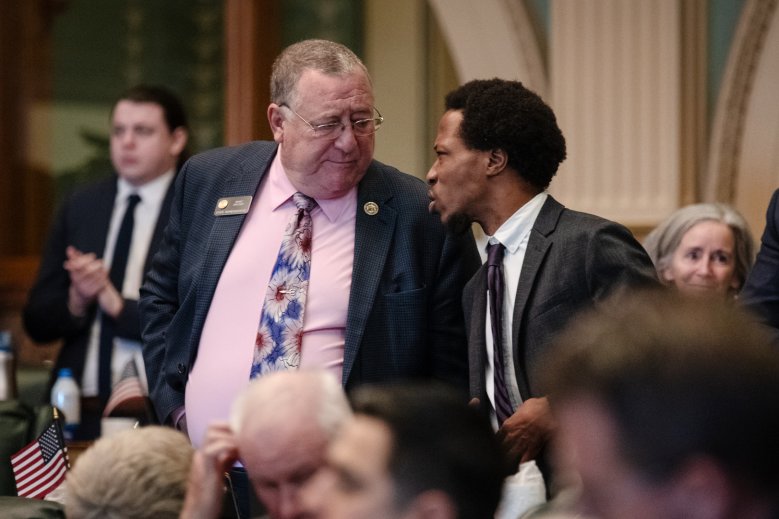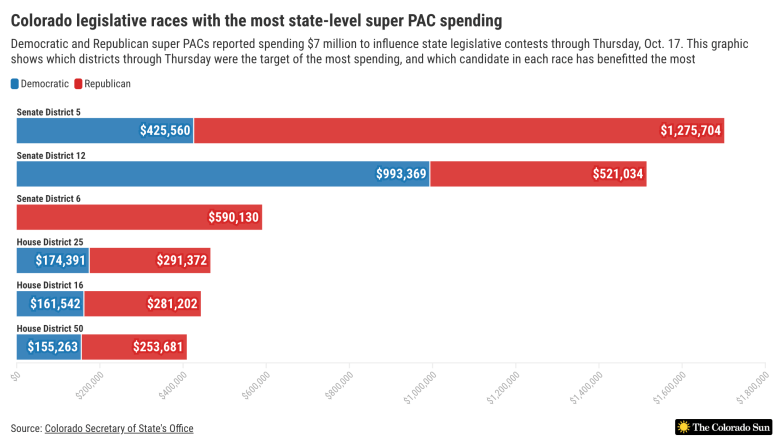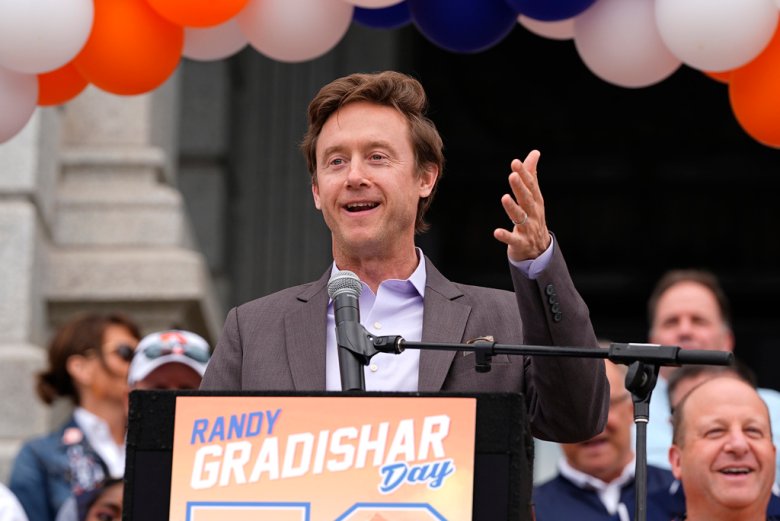
 Rep. Marc Snyder, left, on the first day of the 2024 legislative session Jan. 10 at the Colorado Capitol. The Manitou Springs Democrat is running to represent Senate District 12. (Olivia Sun, The Colorado Sun via Report for America)
Rep. Marc Snyder, left, on the first day of the 2024 legislative session Jan. 10 at the Colorado Capitol. The Manitou Springs Democrat is running to represent Senate District 12. (Olivia Sun, The Colorado Sun via Report for America)
Spending in the legislative battles that will determine how large the Democratic majorities in the state House and Senate will be next year is heating up as Election Day fast approaches.
If Democrats lose three House seats Nov. 5, they lose their supermajority in the House. In the Senate, Democrats need to flip just one seat to secure a supermajority.
If Democrats have supermajorities in both the House and Senate next year, they would be able to refer constitutional amendments to the ballot without Republican support and ask voters to make lasting changes to the tax system and around social issues. Supermajorities would also give Democrats in the legislature the ability to override vetoes by Gov. Jared Polis, who has been a persistent barrier to progressive bills. Polis this year nixed a number of labor-backed measures, and the threat of a gubernatorial veto has previously kept other liberal proposals, like rent stabilization and progressive tax policies, from advancing in the legislature.
About $7 million had been spent through Thursday morning by state-level super PACs on legislative contests. Here are the six races where the most money has been spent so far:
Senate District 5: It’s no surprise that the Senate District 5 race between state Rep. Marc Catlin, R-Montrose, and Democrat Cole Buerger, a small business owner who lives in Glenwood Springs, had drawn the most state-level super PAC spending through Thursday. More than $1.7 million has been spent on this Western Slope district, according to a Colorado Sun analysis, about $1.3 million of it to benefit Catlin. The district is currently represented by Sen. Perry Will, a New Castle Republican appointed to the seat by a vacancy committee; he is running for Garfield County commissioner this year instead of seeking another term. Voters in the district, which is seen as the deciding factor in determining whether Democrats secure a Senate supermajority, have backed Democratic and Republican candidates in other races in the past.
Senate District 12: About $1.5 million had been spent through Thursday morning by state-level super PACs in this race between Rep. Marc Snyder, D-Manitou Springs, and El Paso County Commissioner Stan VanderWerf, a Republican. The district, which leans slightly in Republicans’ favor, is currently represented by term-limited GOP Sen. Bob Gardner. Most of the spending — about $1 million — has been to benefit Snyder. Democrats need to win this seat, along with the District 5 race, to secure a supermajority, and they are confident Snyder will win. (Democrats assume they are going to lose the Republican-leaning Senate District 13 this year, where Democratic Sen. Kevin Priola is term-limited)
Senate District 6: Sen. Cleave Simpson, R-Alamosa, is running for reelection against Democrat Vivian Smotherman, a Durango farmer and Navy veteran, in this district that spans the San Luis Valley into the Four Corners region. About $600,000 has been spent by state-level super PACs on the race, all of it to benefit Simpson. The district is estimated to lean 1 percentage point in Democrats’ favor, but Simpson is known for being a moderate who works across the aisle. If Republicans lose this seat, Democrats will almost surely secure a Senate supermajority, as they would then need to win in either District 5 or District 12, not both, to achieve the advantage — a much easier task.
House District 25: Nearly $500,000 has been spent by state-level super PACs on this race between Rep. Tammy Story, D-Evergreen, and Republican George Mumma, a former police chief. In 2022, Story won in the western Jefferson County district by 729 votes, or about 1 percentage point, in a district estimated to lean 2 percentage points in the GOP’s favor. Story has received about $174,000 in help, while Mumma has gotten $291,000. Republicans see this seat as a prime pickup opportunity.
House District 16: Democratic state Rep. Stephanie Vigil faces Republican Rebecca Keltie, a Navy veteran and self-described anti-establishment candidate, in this Colorado Springs district. About $450,000 has been spent by state-level super PACs on the race, about $161,000 to Vigil’s benefit. Vigil won in 2022 by 710 votes, or 2 percentage points, in the district estimated to lean 3 percentage points in the GOP’s favor, according to a nonpartisan analysis of past election results conducted as part of Colorado’s 2021 redistricting process. Republicans see this seat, too, as a prime pickup opportunity
House District 50: Rep. Mary Young, D-Greeley, will have a rematch with Republican Ryan Gonzalez, who works as a technician at J.M. Smucker, in this Weld County district. State-level super PACs had spent about $400,000 on the contest through Thursday morning, with Gonzalez benefiting from $254,000 of that. Young beat Gonzalez in 2022 by 330 votes, or 2 percentage points, in a district estimated to lean 6 percentage points in Democrats’ favor. The vote margin Young won by in 2022 was the smallest among all legislative races, leading Republicans to focus their efforts on ousting her in November.
 Click the image for an interactive graphic.
Click the image for an interactive graphic.
Colorado Sun correspondent Sandra Fish contributed to this report. We’re so grateful for her expertise and continued help!
WHICH GROUPS ARE SPENDING THE MOST MONEY
A handful of state-level super PACs account for the majority of the outside spending in legislative races. Here is a breakdown of the six biggest players:
The Senate Majority Fund, the state Senate Republican campaign arm, has spent $2.3 million through Thursday morning. The PAC’s single largest donation this cycle so far was $1.4 million from GOPAC Election Fund, a Virginia-based federal PAC that works to get Republicans elected to legislatures across the country.
All Together Colorado, the state Senate Democratic campaign arm, has spent $1.3 million through Thursday morning. The PAC’s single largest donation this cycle so far was $250,000 from the Sixteen Thirty Fund, a Washington, D.C.-based political nonprofit that supports liberal candidates and causes and doesn’t report its donors.
Colorado Way Forward, the state House Democratic campaign arm, has spent $1.26 million through Thursday morning. The group’s single largest donation this cycle came from Rocky Mountain Planned Parenthood, at $200,000.
Coloradans for Accountable Government has spent $601,000 supporting Republican candidates and opposing Democrats. The Colorado Oil and Gas Association has given $530,000 to the committee, while the Colorado League of Charter Schools Action has given $200,000.
New Day Colorado Fund, the state House Republican campaign arm, has spent $537,000 through Thursday morning. That group’s money has come from an affiliated committee, which received its donations from a range of business interests.
Americans For Prosperity Action, affiliated with the conservative political nonprofit with the same name, has spent $196,000 through Thursday morning.
THE GLENWOOD SPRINGS POST INDEPENDENT: Catlin, Buerger both opt for moderate stances on issues impacting Senate District 5 but subtle differences emerge
A conversation with Mike Johnston about Denver Ballot Issue 2R
 Denver Mayor Mike Johnston introduces Denver Broncos Ring of Fame linebacker Randy Gradishar during a celebration outside the Colorado Capitol on May 3 in Denver. (AP Photo/David Zalubowski)
Denver Mayor Mike Johnston introduces Denver Broncos Ring of Fame linebacker Randy Gradishar during a celebration outside the Colorado Capitol on May 3 in Denver. (AP Photo/David Zalubowski)
The Unaffiliated spoke with Denver Mayor Mike Johnston this week about his campaign to raise the city sales tax by 0.5 percentage points to fund affordable housing.
Here are some highlights from our interview on Ballot Issue 2R. Responses edited for length and clarity.
On how Denver landed on a $100 million sales tax increase:
“We actually started with what is the problem we’re trying to solve, and what’s the scale of solving that?” Johnston said. “There’s a DRCOG (Denver Regional Council of Governments) study that says Denver over the next 10 years is 45,000 units short of affordable housing, so that’s the scale. And then we backed the math out from there. What would it take to be able to build 4,500 units a year for 10 years to make Denver one of the only cities that actually has a path to meet that total need? We’ll need about $100 million a year. And so this was designed exactly to meet the scale of the problem Denver has.
“We think this is part of the challenge of the measures that have been put in place in the past. While well intended and a good step in the right direction, they haven’t put together a plan at the scale of the problem. And so people continue to be frustrated. They don’t see us making progress.”
On why the program doesn’t focus exclusively on lower-income residents who make less than 60% of the area median income, when the DRCOG study shows they face the greatest housing challenges:
“Every teacher, nurse, firefighter, senior citizen retiree in the city — those people are almost all at 60, 80, 100% of AMI. And you don’t have to go far to talk to anyone living in the city on that income that says that they cannot afford to stay here anymore. We do have real gaps at 60 to 80% (of area median income). We have gaps at 80 to 100%. So there is clearly need at all levels.
“What we hear overwhelmingly from people is that working class folks are being forgotten in the city. There are a lot of programs right now for zero to 60, there are very few programs for 60 to 100% and so we think it’s important to do both, and this allows us to do both. We’ll definitely prioritize zero to 60, and we have language in the ordinance that says we’ll focus on where the greatest need is. So if the greatest need continues to be at zero to 60, we’ll keep our focus there, but we cannot forget about the working families that make the city run.”
On whether the city needs more zoning changes to develop this much housing:
“We have the zoning capacity to build this kind of density, and we already have places where it’s coming. We’re about to start bus rapid transit along Colfax, with a lot of opportunity for density there. We have thousands of affordable units that are zoned, permitted, in our application pool, and those projects have all stalled because we don’t have financing to get them done. We had 19 projects that applied for (federal low-income housing tax credit) funds in Denver this last cycle, only four of them got it. That means there were 15 projects ready to build that are going to stall for lack of financing. So we think the real crisis right now is financing.”
On why he proposed a sales tax:
“We didn’t want to do property tax, because we’re trying to get that under control. We don’t have an income tax option. There really is sales or property and we think this is the right one.
“It does not apply to groceries, does not apply to gas, to medical supplies, personal hygiene products, so it literally isn’t the core basket of goods you’re going to support your family with. Thirty-five percent of sales tax is paid by visitors outside of Denver.
“The total burden on a family is about $2 a week. And so you think about that $2 a week, that’s $8 a month, compared to, if you are a teacher making $60,000 and you should be paying $1,500 a month (in rent), and (instead) you’re paying $2,500 — that saves you $1,000 a month to pay $2 a week. If you’re a server making minimum wage at $35,000 a year, $800 or $1,000 a month is life changing.”
Want to reach Colorado political influencers and support quality local journalism? The Sun can help get your message attention through a sponsorship of The Unaffiliated, the must-read politics and policy newsletter in Colorado. Contact Sylvia Harmon at [email protected] for more information.
The money left in Denver Mayor Mike Johnston’s 2020 U.S. Senate campaign account
When a candidate ends a congressional bid, they can choose to close their federal campaign account or keep the money with an eye toward the future and sometimes another run for federal office, which the dollars can be used toward.
The dollars may be also used to make contributions to other federal, state and local candidates, as well as to make contributions to political parties or to charitable organizations, according to the Federal Election Commission.
But five years after Johnston ended his 2020 U.S. Senate bid when Democrat John Hickenlooper jumped into the race, he’s still sitting on a massive pile of cash.
Johnston reported spending about $4,000 in July, August and June, half of it on a donation to the Democratic Party of Denver and the other half to his accountant, John Morse, the former president of the Colorado Senate and a fellow Democrat.
Johnston isn’t the only former Colorado congressional candidate who still has a mountain of cash in their federal campaign account. The others include:
Former state Sen. Kerry Donovan, D-Vail, who is sitting on $370,000 left over from her 2022 bid in the 3rd Congressional District. She dropped out of the race after her home was drawn out of the district.
Ike McCorkle, a Democrat who has run unsuccessfully to represent the 4th Congressional District for three consecutive election cycles. He lost in the Democratic primary this year. McCorkle ended September with more than $100,000 in the bank after spending $125,000 during the recent fundraising quarter. He told The Unaffiliated he plans to run for the seat again in 2026.
Former U.S. Rep. Scott Tipton, a Cortez Republican who lost in the 2020 Republican primary in the 3rd District to Lauren Boebert, had more than $300,000 in the bank at the end of June when he last filed with the FEC. He owes a report to the FEC on his most recent fundraising and spending.
ELECTION 2024
U.S. Sen. Michael Bennet, D-Colorado, has been barnstorming across the country for Democratic candidates, including Vice President Kamala Harris in her bid for the White House.
His staff reports he’s made recent stops in Arizona, Ohio, Pennsylvania, Wisconsin, New Hampshire and Nebraska. Keep in mind that Bennet hasn’t ruled out another presidential bid. He’s not up for reelection to his Senate seat until 2028.
3RD CONGRESSIONAL DISTRICT
Democrat Adam Frisch is running a new, abortion-focused TV ad in his bid to represent Colorado’s 3rd Congressional District. The former Aspen city councilman says the 30-second spot, which attacks his opponent, Republican Jeff Hurd, coincides with his new “Women for Frisch” coalition.
8TH CONGRESSIONAL DISTRICT
The National Republican Congressional Committee and U.S. Rep. Yadira Caraveo, D-Thornton, are each running new TV ads in the 8th Congressional District.
Caraveo’s ad touts her work to drive down the cost of health care. The NRCC ad features a drug enforcement officer blaming Caraveo for the increase in fentanyl in Colorado, citing her vote to defelonize the opioid.
READ MORE
 = source has article meter or paywall
= source has article meter or paywall
Campaign finance tidbits we had to tell you about
It’s that time of year where money is flocking to campaigns like the salmon of Capistrano.
Here are some recent notable donations:
The issue committee supporting Proposition 131 received a handful of big donations Wednesday. Kimbal Musk, the brother of billionaire Elon Musk, donated $100,000. Billionaire Larry Mizel, a Republican megadonor, donated $50,000 to the group on Wednesday. Private equity executive Charles Gallagher gave $10,000.
Kimbal Musk donated $250,000 in July to Unite America PAC, the federal spending committee of the Denver-based nonprofit of the same name that supports Proposition 131.
Kent Thiry, the wealthy former CEO of the Denver-based dialysis giant DaVita, spread the love this week, donating $100,000 to Coloradans for Protecting Reproductive Freedom, the issue committee supporting Amendment 79; $50,000 to Freedom to Marry Colorado, the issue committee supporting Amendment J; and $25,000 to Yes on JJ, the issue committee supporting Proposition JJ. Thiry is the lead proponent of Proposition 131 and he’s cochair of the Unite America board.
Voters Rights Colorado, the group opposing Proposition 131, received $25,000 each from Cobalt Advocates and the Colorado Fund for Children and Public Education, as well as $10,000 from the Southwest Regional Council of Carpenters.
 = source has article meter or paywall
= source has article meter or paywall
Corrections & Clarifications
Notice something wrong? The Colorado Sun has an ethical responsibility to fix all factual errors. Request a correction by emailing [email protected].
Type of Story: News
Based on facts, either observed and verified directly by the reporter, or reported and verified from knowledgeable sources.
Author :
Publish date : 2024-10-18 04:52:00
Copyright for syndicated content belongs to the linked Source.
Author : theamericannews
Publish date : 2024-10-20 00:43:48
Copyright for syndicated content belongs to the linked Source.
